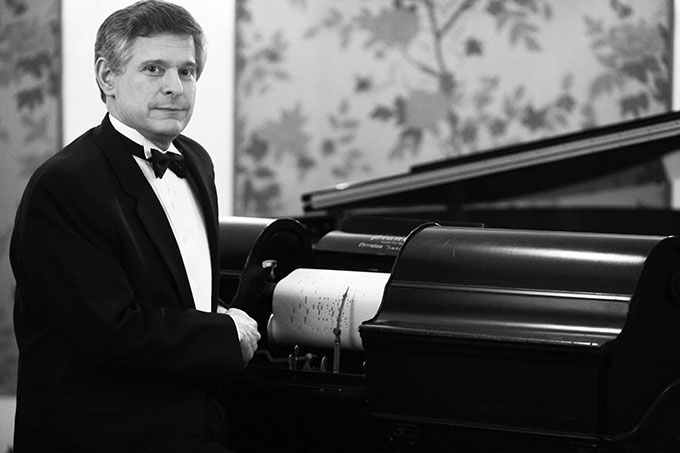Ballets Russes Mecaniques
by Jan Jezioro

Bob Berkman will demonstrate at the National Gallery of Art why the pianola still rules
On a fine evening late last spring, Bob Berkman welcomed a small group of guests to his West Side home for an impromptu performance of Lithuanian folk music on a pianola, or player piano. The occasion for this recital, held in a private home, as were almost all pianola performances in the instrument’s heyday, was the visit to Buffalo of Professor Darius Kucinskas, a musicologist at the University of Kaunas in Lithuania. As Berkman explains, “Darius was somehow bitten by the player piano bug and he is now compiling a catalog of Lithuanian piano rolls.” Berkman’s interest in the neglected area of ethnic rolls had prompted him to establish the largest institutionally held collection of such rolls at the UCLA Ethnomusicology Archive, where he has taught and performed as a visiting scholar.
Kaunas is the home of a yearly festival, jointly celebrating the music of Mikalojus Ciurlionis, a fin de siècle Lithuanian symbolist painter and prolific composer, and also, somewhat surprisingly, the music of the Norwegian composer Edvard Grieg. Kucinskas was so enthusiastic about Berkman’s virtuosity that “he proposed to the festival organizers that they bring me over for a pianola program, a proposal that he reports was ‘accepted with enthusiasm.’”
“Grieg was a pianola enthusiast,” says Berkman, “and there are lots of rolls of his music, some played by him, but I would have to make rolls of Ciurlionis’s music. A highlight of my performance at the festival would be the Grieg Piano Concerto, with myself as pianola soloist with the Kaunas Philharmonic. I played the first movement in a concert last month at Indiana University of Pennsylvania, with the orchestra reduction played by music faculty pianist Henry Wong Doe on a second piano”.
The player piano or pianola is a self-playing piano that employs a mechanism, usually pneumatic in nature, to operate the piano action using a preprogrammed, perforated paper roll. During the late 19th century and through the early 1920s, the increasing purchase of mass-produced pianos for the home fueled the demand for player pianos. The introduction of electrical recording methods developed in the mid-1920s, which greatly improved the sound of phonograph records, the refinement of the wireless, with its improved electrical sound amplification, and the Wall Street crash of 1929, ultimately sealed the fate of the pianola.
But during its decades of popularity, Berkman explains, “the pianola was embraced as an instrument of self-expression. The operator of a pianola, known as a ‘pianolist,’ was expected to impart his or her own interpretation to the rolls by using the instrument’s foot and hand controls. Dynamics and accents are created by subtle and well-timed variations in pressure on the foot pumps; the sustain pedal, bass/treble balance, and tempo are controlled by levers.”
Berkman started working in 1975 for the Buffalo-based QRS, the world’s last piano roll manufacturer, producing innumerable reissues of historic roll recordings and creating a constant flow of new recordings for over 30 years. His credits include rolls commissioned for the films Ragtime, and Reds, the last in cooperation with composer Stephen Sondheim, and he has appeared on NPR, the BBC, and CBS Sunday Morning.
The National Gallery of Art in Washington, DC is currently presenting an exhibition of portraits, costumes, and scenery from Sergei Diaghilev’s famed Ballets Russes as part of its celebration of the centennial of the premiere of Stravinsky’s epochal score for the ballet Rite of Spring. Berkman, who has been honored by being invited to the National Gallery to give a recital on Wednesday, May 15 of works written by composers associated with Diaghilev, notes, “The heyday of the player piano coincided with Diaghilev’s Ballets Russes [1909-1929], widely regarded as one of the most remarkable artistic endeavors of the 20th century. Many of the composers whom Diaghilev commissioned, including Debussy, Ravel, Milhaud, and Poulenc are represented on piano rolls, though not always by their own hands and not always by their Ballets Russes works. Even so, the rolls of their music that have come down to us provide an aural glimpse of their brilliance through a medium very much in vogue in Diaghilev’s day.”
A highlight of the program will be the pianola world premiere of Erik Satie’s score to the ballet Parade, a 1915 work with costumes and sets by Pablo Picasso, described by the poet Guillaume Apollinaire as “a kind of surrealism.”
“As far as I can tell, Parade was never issued on rolls before, so I made them myself,” says Berkman. “The orchestral score published in 1919 contains nine pieces, but the four-hand piano version published in 1917 contains only seven pieces. The missing ‘Choral’ and ‘Finale’ came to light and were published in 1999.”
blog comments powered by Disqus|
Issue Navigation> Issue Index > v12n19 (Week of Thursday, May 9) > Ballets Russes Mecaniques This Week's Issue • Artvoice Daily • Artvoice TV • Events Calendar • Classifieds |









 Current Issue
Current Issue